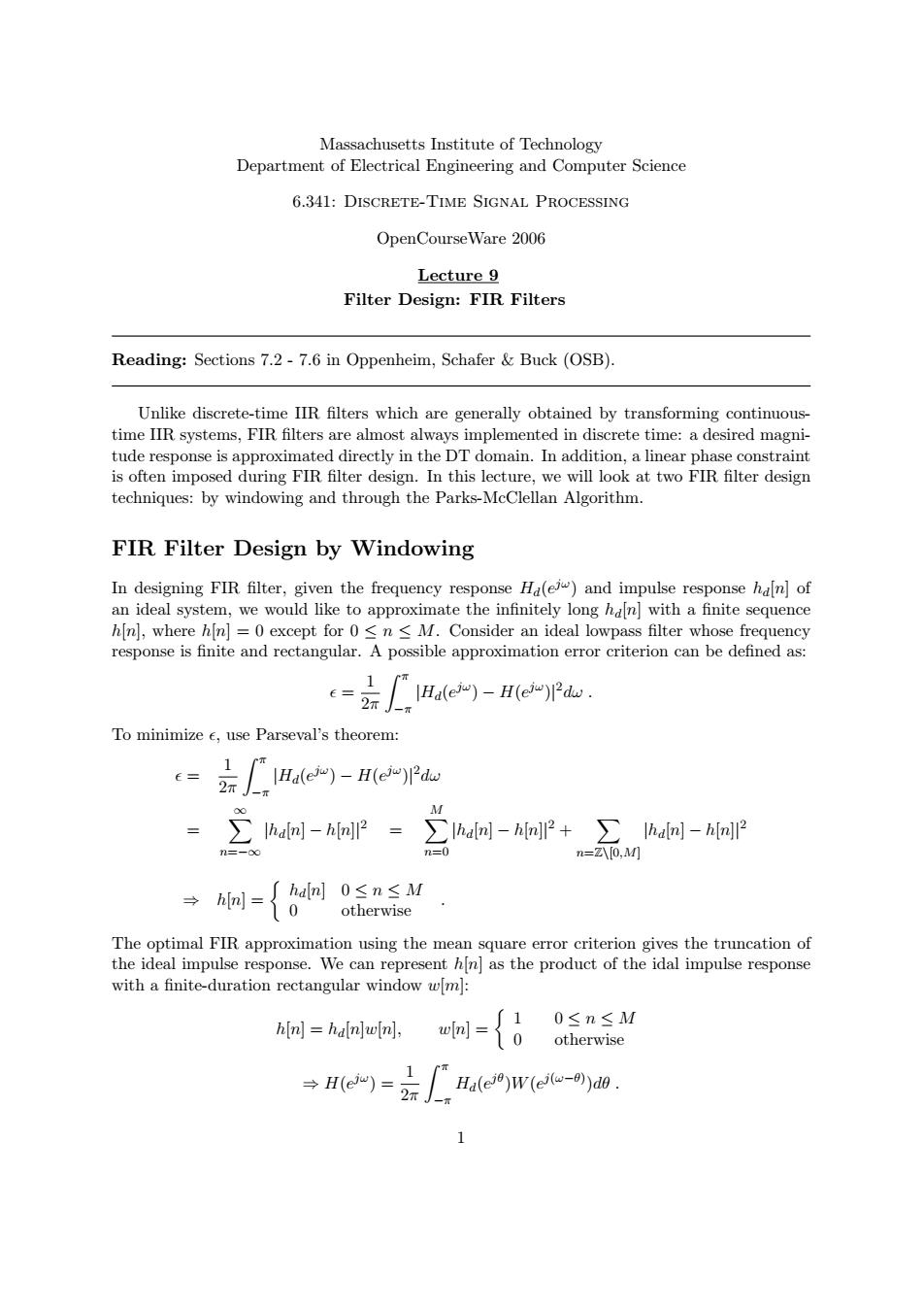正在加载图片...

Massachusetts Institute of Technology Department of Electrical Engineering and Computer Science 6.341:DISCRETE-TIME SIGNAL PROCESSING OpenCourse Ware 2006 Lecture 9 Filter Design:FIR Filters Reading:Sections 7.2-7.6 in Oppenheim,Schafer Buck (OSB). Unlike discrete-time IIR filters which are generally obtained by transforming continuous- time IIR systems,FIR filters are almost always implemented in discrete time:a desired magni- tude response is approximated directly in the DT domain.In addition,a linear phase constraint is often imposed during FIR filter design.In this lecture,we will look at two FIR filter design techniques:by windowing and through the Parks-McClellan Algorithm. FIR Filter Design by Windowing In designing FIR filter,given the frequency response Ha(eiw)and impulse response haln]of an ideal system,we would like to approximate the infinitely long haln]with a finite sequence hn],where h[n]=0 except for 0<n M.Consider an ideal lowpass filter whose frequency response is finite and rectangular.A possible approximation error criterion can be defined as: 1 E= (e)-H)pav. To minimize e,use Parseval's theorem: ( ()-mea ∑hal-hmP=∑haln-imP+∑lham-hm2 n=-0 n=0 n=Z\[0,M] 响={0sn≤ otherwise The optimal FIR approximation using the mean square error criterion gives the truncation of the ideal impulse response.We can represent hn]as the product of the idal impulse response with a finite-duration rectangular window w[m: hin]haln]wlnl, w={0 0≤n≤M otherwise Ha(ej)w(e)do 1Massachusetts Institute of Technology Department of Electrical Engineering and Computer Science 6.341: Discrete-Time Signal Processing OpenCourseWare 2006 Lecture 9 Filter Design: FIR Filters Reading: Sections 7.2 - 7.6 in Oppenheim, Schafer & Buck (OSB). Unlike discrete-time IIR filters which are generally obtained by transforming continuoustime IIR systems, FIR filters are almost always implemented in discrete time: a desired magnitude response is approximated directly in the DT domain. In addition, a linear phase constraint is often imposed during FIR filter design. In this lecture, we will look at two FIR filter design techniques: by windowing and through the Parks-McClellan Algorithm. FIR Filter Design by Windowing In designing FIR filter, given the frequency response Hd(ejω) and impulse response hd[n] of an ideal system, we would like to approximate the infinitely long hd[n] with a finite sequence h[n], where h[n] = 0 except for 0 ≤ n ≤ M. Consider an ideal lowpass filter whose frequency response is finite and rectangular. A possible approximation error criterion can be defined as: 1 � π Hd(ejω) − H(ejω � = )| 2dω . 2π | −π To minimize �, use Parseval’s theorem: � = 2 1 π � π |Hd(ejω) − H(ejω)| 2dω −π ∞ 2 M 2 = � hd[n] − h[n] = � hd[n] − h[n] � hd[n] − h[n] n= | | n=0 | | 2 + n=Z\[0,M] | | −∞ � hd[n] 0 ≤ n ≤ M h[n] = 0 otherwise ⇒ . The optimal FIR approximation using the mean square error criterion gives the truncation of the ideal impulse response. We can represent h[n] as the product of the idal impulse response with a finite-duration rectangular window w[m]: � 1 0 ≤ n ≤ M h[n] = hd[n]w[n], w[n] = 0 otherwise 1 � π H(ejω) = Hd(ejθ)W(ej(ω−θ) ⇒ )dθ . 2π −π 1